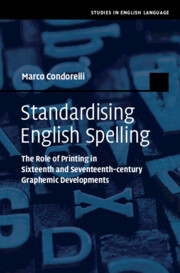 Standardising English Spelling
Standardising English Spelling Book contents
- Standardising English Spelling
- Studies in English Language
- Standardising English Spelling
- Copyright page
- Contents
- Figures
- Tables
- Acknowledgements
- Abbreviations
- Chapter 1 Introduction
- Part I Context
- Part II Empirical Method
- Part III Case Studies
- Chapter 7 The Standardisation of Positional Spellings
- Chapter 8 The Standardisation of i and y
- Chapter 9 The Standardisation of Etymological Spelling
- Chapter 10 The Standardisation of Vowel Diacritic Spelling
- Chapter 11 Conclusion
- Bibliography
- Index
Chapter 7 - The Standardisation of Positional Spellings
from Part III - Case Studies
Published online by Cambridge University Press: 31 March 2022
- Standardising English Spelling
- Studies in English Language
- Standardising English Spelling
- Copyright page
- Contents
- Figures
- Tables
- Acknowledgements
- Abbreviations
- Chapter 1 Introduction
- Part I Context
- Part II Empirical Method
- Part III Case Studies
- Chapter 7 The Standardisation of Positional Spellings
- Chapter 8 The Standardisation of i and y
- Chapter 9 The Standardisation of Etymological Spelling
- Chapter 10 The Standardisation of Vowel Diacritic Spelling
- Chapter 11 Conclusion
- Bibliography
- Index
Summary
Chapter 7 deals with the redistributions of ˂u˃/˂v˃ and ˂i˃/˂j˃ in word-initial position. The main empirical finding is a sudden shift from an earlier graphotactic distribution to a phonographic one, which occurred between the 1620s and 1640s. From the quantitative and qualitative results collected for the positional spellings, a compelling linguistic scenario becomes apparent behind the positional redistribution. By taking an eclectic, large-scale perspective on spelling standardisation, one can overcome some of the variables that inevitably correlate, and likely underlie, any abrupt spelling changes in small, specific collections, for example the latent influence of different exemplars between different editions of an individual text. Departing from a more precise understanding of the chronology and the lexical diffusion of the positional spellings, this case study uncovers, for the first time, some of the mechanisms involved in the uses of different positional spelling conventions between the sixteenth and the seventeenth centuries. In particular, the chapter argues for a close connection between the abrupt, one-generational changes in the uses of word-initial ˂u˃/˂v˃ and ˂i˃/˂j˃, and compositional factors that affected the Early Modern English printing industry.
- Type
- Chapter
- Information
- Standardising English SpellingThe Role of Printing in Sixteenth and Seventeenth-century Graphemic Developments, pp. 127 - 149Publisher: Cambridge University PressPrint publication year: 2022


